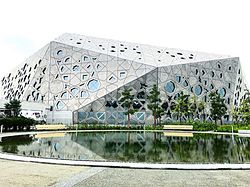| Sheikh Jaber Al-Ahmad Cultural Centre | |
|---|---|
مركز الشيخ جابر الأحمد الثقافي | |
 Back view of the Sheikh Jaber Al-Ahmad Cultural Centre | |
 | |
| Alternative names | Kuwait Opera House |
| General information | |
| Status | Completed |
| Type | Performing arts centre |
| Architectural style | Expressionist |
| Location | Shuwaikh |
| Address | Shuwaikh, Kuwait |
| Country | Kuwait |
| Coordinates | 29°21′36.1″N47°57′21.4″E / 29.360028°N 47.955944°E |
| Construction started | 2013 |
| Completed | February 2016 |
| Inaugurated | 31 October 2016 |
| Cost | US $775 million |
| Owner | Amiri Diwan |
| Technical details | |
| Floor area | 214,000 m2 (2,303,500 sq ft) |
| Design and construction | |
| Architect(s) | SSH |
| Other information | |
| Seating capacity |
|
| Parking | 3 subterranean levels |
| Website | |
| https://www.jacc-kw.com/ | |
The Sheikh Jaber Al-Ahmad Cultural Centre (JACC), informally known as the Kuwait Opera House, is a cultural center in Kuwait, located on the Gulf Road in the capital Kuwait City. It is the largest cultural center and opera house in the Middle East. [1] [2] [3] The cultural centre is part of the Kuwait National Cultural District. [4] [5]
Contents
The Sheikh Jaber Al-Ahmad Cultural Centre is a multidisciplinary public space owned by the Amiri Diwan. [6] It offers a range of events in music, theatre, film, workshops and spoken word. [6]
The cultural complex, which includes theatres, concert halls, music centres, conference and exhibition halls, cinemas, libraries, center for historical documents, and public park, took two years to complete. [7] [1] It is 214,000 m² in size and had a budget of US$775 million. [8] [9] [10]